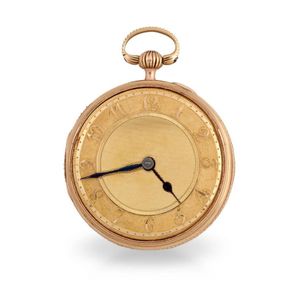Cabrit Geneve Tri-Colour Gold Diamond Watch
You must be a subscriber, and be logged in to view price and dealer details.
Subscribe Now to view actual auction price for this item
When you subscribe, you have the option of setting the currency in which to display prices to $Au, $US, $NZ or Stg.
- Circa - A Latin term meaning 'about', often used in the antique trade to give an approximate date for the piece, usually considered to be five years on either side of the circa year. Thus, circa 1900 means the piece was made about 1900, probably between 1895 and 1905. The expression is sometimes abbreviated to c.1900.
- Fusee - The fusee movement was used in clocks and pocket watches from the mid 17th century. The fusee is a cone shaped drum within the works that is linked to the barrel of the spring, usually by a length of chain.
As the mainspring loses its tension over time, the cone shaped barrel compensates for this by increasing the tension, by pulling the mainspring tighter, thus ensuring the time remains constant.
Use of the fusee in clocks was superseded by the "going barrel" in the mid 19th century and for pocket watches at the beginning of the 19th century.
The fusee continued to be used in marine chronometers until the 1970s. - Movement - The technical name for the workings of a clock or watch, and does not include the dial or case.
- Embossed / Repousse - Embossing, also known as repousse, is the technique of decorating metal with raised designs, by pressing or beating out the design from the reverse side of the object.It is the opposite of chasing, where the decoration is applied from the front. An embossed or repoussed object may have chasing applied to finish off the design.
- Bezel - On a clock or watch, the bezel is the metal frame into which the watch or clock glass is fitted. In clocks, the bezel may include a hinge and a flange, in effect a door to the face of the clock. In jewellery the bezel is a band of metal with a projecting lip that holds the gemstone in its setting.
This item has been included into following indexes:
Visually similar items

A rare early 19th century gold Swiss/French automata Repeat/Strike pocket watch, cobalt blue chapter ring with relief silver and gold figures that strike the hours and quarter on demand. Verge movement pierced cockplate with end stone. Diameter 54 mm.

David Morice An 18ct gold open-faced pocketwatch mvt 4429 English circa 1840, english fusee cylinder movement signed and numbered David Morice, Fenchurch Street no. 4429, cylindrical pillars, diamond endstone, gold engine-turned dial, Arabic numerals, blue

A 14ct gold lady's pocket watch, golden dial with Roman numerals, stem wind push piece at 1oclock in a finely engraved case. Working but stops.

A gold open-faced Jacquemart automaton quarter repeating pocket watch Continental circa 1810, gilt full plate movement, verge fusee escapement, pierced and engraved balance cock, two hammers striking on two gongs, skeletonised dial, engraved automaton Jacq
